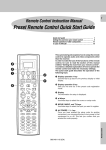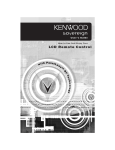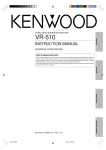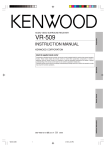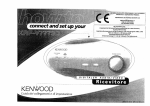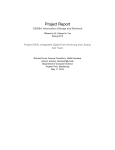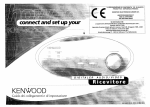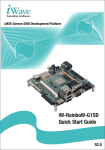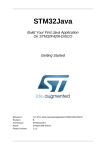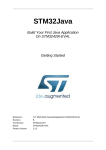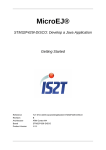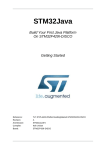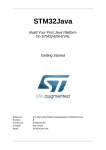Download ComposerMVC User Guide - Index of
Transcript
ComposerMVC User Guide
ComposerMVC User Guide
By Paul Done
Version 1.0 – 26/05/2004
Page 1/11
ComposerMVC User Guide
1. Introduction
ComposerMVC is Model-View-Controller (MVC) framework for use in exteNd Composer projects.
Typically Novell's exteNd Composer product is used by developers to create web services which
represent an organisation's processes. These services usually encapsulate data and logic which
already exist in one or more back-end systems.
The user interface for Composer developed web services are normally constructed using other
products and programming languages. These products are used to consume the Composer web
services. For example: an exteNd Director portal, a C# .NET GUI application, or a J2EE web
application.
Since version 5.0, exteNd Composer has provided native capabilities for creating simple HTML
interfaces using the Java Server Pages (JSP) technology. However, on its own this capability is
fairly limited and, if used, forces the developer to embed large sections of Java code (scriptlets)
within the Composer JSPs. Validation, inter-page navigation and linking is also very difficult to
achieve using Composer JSPs.
The ComposerMVC framework introduces the MVC design pattern
(http://java.sun.com/blueprints/patterns/MVC.html) to a Composer project to try to eliminate some
of these shortcomings. A ComposerMVC project can be divided into the three logical sections:
•
Model : the normal Composer Web Services that integrate with back-end systems;
•
View: a set of standard Composer JSPs displaying a mix of static HTML and
dynamically generated HTML (via the standard Composer Tag Library);
•
Controller: a special 'container' JSP, a special 'controller' web service and a set of
'action' XML Map components.
The benefits of the ComposerMVC framework are:
•
developers build web services in the normal way, enabling these web services to
subsequently be used remotely and unchanged if a future decision is made to move to a
full user interface toolkit such as exteNd Director later on in a project's lifetime;
•
normal JSPs contain no scriptlet code and only use HTML, standard JSP syntax and
Composer's standard tag library to dynamically generate pages, thus reducing the
overhead of page creation and maintenance;
•
all validation logic for HTML Form submission, calls to update or query the model and
navigation logic to determine what view to display, is implemented in individual 'action'
components, where programmatic logic is most easily accomplished in Composer.
The ComposerMVC framework is NOT a replacement for a fully fledged user interface toolkit such
as exteNd Director. Ideally, such toolkits should be used given sufficient skills, resources and
licenses. However this is not an ideal world, hence this framework can provide a service to a
development team which falls into one of the following three categories:
•
the team has little or no Java/J2EE experience;
•
the team does not posses licenses for exteNd Director (the preferred UI creation toolkit
for Composer web services);
•
the team is creating an HTML web application using mostly static or content managed
pages and only a small part of the application needs to dynamically generate content.
Note: This document assumes that the reader already has a familiarity with Novell's exteNd
Composer product.
Version 1.0 – 26/05/2004
Page 2/11
ComposerMVC User Guide
2. Framework Structure
2.1 Control Flow
The diagram below shows the basic structure of a ComposerMVC project. In a Composer project,
the Container JSP and Web Service parts of the Controller are pre-supplied and do not need to be
created or modified. The only part of the Controller requiring development effort is the creation of
the individual Action components (XML Map components) which respond to HTML Form
submissions.
Controller Web Service
Container JSP
Controller
Page 1
JSP
View
Page 2
JSP
View
Page 3
JSP
View
Action 1
XML Map
Component
Error
JSP
View
Action 2
XML Map
Component
Action n
XML Map
Component
Web Service 1
Web Service 2
Model
Web Service 3
Web Service n
Key: Blue = Model, Grey = View, Yellow = Controller
The typical flow of control for deployed ComposerMVC projects is:
1) Via a browser, an end user access the URL of the main controller JSP (Container JSP)
2) The main controller JSP determines that for this user, the first view should
automatically be shown and forwards the request straight to the Page 1 JSP view to
generate a HTML page.
3) The result HTML page typically contains an HTML Form, which includes two special
hidden input items ('Controller' name and 'Action' name) in addition to normal HTML
input items and submit buttons.
4) The user enters some data and presses submit, which sends the HTTP Post request
back to the URL of the controller JSP.
5) The controller JSP uses the two hidden parameters ('Controller' name and 'Action'
name) to determine which custom Action component to call and invokes the Action
component passing the input DOM (which contains all the submitted input items).
6) The Action XML Map component converts the input DOM to the format required by the
web service(s) it will call, validates that all correct input parameters for the web service
are present, and then invokes the web service with the modified DOM.
7) Once the web service has completed, the Action component checks the result output
DOM from the web service and then identifies which result view (JSP) should be shown
as a result, passing this back to the calling Controller web service. The Action
component also checks for any errors which may have occurred in the called web
service. Any error messages generated are also placed in its output DOMs, for use by
the Controller web service.
Version 1.0 – 26/05/2004
Page 3/11
ComposerMVC User Guide
8) If the output DOMs received by the Controller web service from the Action component,
contains the name of a View JSP to show, the Controller web services then forwards the
request to the result view JSP along with the output DOM. If the Controller web service
does not receive an output DOM containing the result view name, the Controller
forwards the request with any error messages (if present) to the Error view JSP.
9) The result view JSP uses static HTML, normal JSP actions/tags and the Composer tag
library to take the result DOM from the web service and render it in the result HTML
page. If this page also contains an HTML Form and the user presses submit in this form,
then the whole flow cycle is repeated again.
10)If the error pages is forwarded to, the error page displays a generic message and if any
error messages are passed to it, displays theses as well (again using static HTML,
normal JSP syntax and Composer tags).
2.2 Inputs and Outputs
Typically a JSP which contains a HTML Form for submission to a ComposerMVC application, will
contain HTML source similar to the following:
<FORM METHOD="POST" ACTION='orders'>
<INPUT TYPE="hidden" NAME="Controller" VALUE="ordersController">
<INPUT TYPE="hidden" NAME="Action" VALUE="searchAction">
<P>Surname: <INPUT TYPE="text" NAME="LastName"></P>
<P>Account Id: <INPUT TYPE="text" NAME="Account"></P>
<P><INPUT TYPE="submit" NAME="search" VALUE="Search"></P>
</FORM>
This example shows an order lookup form where the user is expected to enter his/her last name
and account id to be able to lookup his/her existing orders.
In the ComposerMVC project, the main controller JSP will be associated with the web-application
URL '/orders'. When invoked, the Controller JSP uses the standard Composer 'execute' tag to
invoke the Controller Web Service which will receive this input DOM in the following format:
<ROOT>
<Controller>ordersController</Controller>
<Action>searchAction</Action>
<LastName>Bloggs</LastName>
<Account>8437393</Account>
<submit>Search</submit>
</ROOT>
The controller web service is then able to invoke the Action Component (XML Map) called
'searchAction'. Using the standard Composer map instructions, this Action Component converts
the input DOM into the DOM format required by the proper web service to be called. For example:
<AccountSearch>
<LastName>Bloggs</LastName>
<Account>8437393</Account>
Version 1.0 – 26/05/2004
Page 4/11
ComposerMVC User Guide
</AccountSearch>
The output of both an Action Component and the Controller Web Service is actually two DOMs: (i)
a normal output DOM, and (ii) a special 'metadata' DOM. The output DOM can contain anything
and just reflects the output of the normal web service called from the model. The metadata DOM
has a special structure used by the Controller Web Services and Action Components.
For this example the output DOM (originally from the normal model web service) may be similar to
the following:
<Account>
<FirstName>Joe</FirstName >
<LastName>Bloggs</LastName>
<Addresses>
<Address>
<House>32</House>
<Street>Sea Avenue</Street?
<Town>Sunnytown</Town>
<Postcode>ST2 1AZ</Postcode>
</Address>
<Address>
<House>ACME House</House>
<Street>ACME Park</Street?
<Town>Grey City</Town>
<Postcode>GC1 1BB</Postcode>
</Address>
</Addresses>
</Account>
...and the metadata DOM may have the following content:
<MetadataOutput>
<TargetView>orders_showresults</TargetView>
<Errors/>
</MetadataOutput>
...however if there was a validation error or normal web service error, there may be an empty
output DOM and the metadata DOM may have the following content:
<MetadataOutput>
<TargetView>orders_errorpage</TargetView>
<Errors>
<Message>An account last name has not been specified</Message>
<Message>An account first name has not been specified</Message>
</Errors>
</MetadataOutput>
The 'TargetView' element of the metadata DOM tells the main controller JSP which normal view
JSP should be forwarded to. The 'Errors' elements of the metadata data DOM is stores any error
Version 1.0 – 26/05/2004
Page 5/11
ComposerMVC User Guide
messages which need to be displayed to the user.
In the example where the validation error occurred, a separate error JSP is used to show the error
messages. Alternatively, it is perfectly acceptable for the target view element to be set by the
Action component the the name of original search JSP. In this case the search JSP can show the
error messages on the same page as the offending input items, thus enabling the end user to resubmit with correct data.
For this example, if the validation was successful and the web service returned an Output DOM
containing the account details and metadata DOM with the 'orders_results' JSP set as the target
view, the 'orders_results' JSP could have the following example content to show the results:
<H1>Account Details</H1>
<P> First Name: <composer:value name="data" xpath="/Account/FirstName"/> </P>
<P> Last Name : <composer:value name="data" xpath="/Account/LastName"/>
</P>
<composer:forEach name="data" xpath="/Account/Addresses/Address">
<P> Postcode: <composer:value xpath="Postcode"/>
</composer:forEach>
..and alternatively, if any errors were returned in the metadata, a special error JSP or even a
normal error JSP could display the errors in a manner similar to the following:
<P>The input data was invalid, please try again.</P>
<composer:hasvalue name="data" part="Metadata" xpath="/MetadataOutput/Errors">
<composer:forEach name="data" part="Metadata" xpath="/MetadataOutput/Errors">
<P>Error: <composer:value xpath="Message"/> </P>
</composer:forEach>
</composer:hasvalue>
Observe that in the three example JSPs (orders_search, orders_showresults and
orders_errorpage) only standard HTML tags, standard JSP syntax and the Composer Standard
Tag Library are used. Also the normal web services (in the model) take a normal single input DOM
and return a normal single output DOM and are thus not directly tied into the ComposerMVC
framework structure.
Version 1.0 – 26/05/2004
Page 6/11
ComposerMVC User Guide
3. Starting a New Project
3.1 Steps
To use the ComposerMVC framework in an exteNd Composer 5.0 project, either unzip and copy
the skeleton 'composermvc' project or choose to create a new empty project and import the
relevant Xobjects from the skeleton 'composermvc' project into the new project. The following list
describes all the elements which need to be included in a project to incorporate the
ComposerMVC framework:
1) Rename the main Container/Controller JSP, called 'myapp' to the name of the
application it is required for (eg. 'orders').
2) Rename the main Controller Web Service, called 'myappController' to the same name
as the controller JSP suffixed by the word 'Controller' (eg. 'ordersController').
3) Select the 'Tools | Project Settings' menu option in the Composer Designer and add two
new project variables to specify the name of the first page and the error page,
respectively, for the application. For example:
•
Name: 'ordersController_FirstView' – Value: 'orders_search'
•
Name: 'ordersController_ErrorView' – Value: 'orders_errorpage;
4) At the top of each View JSP include the following two lines to ensure that the Composer
Tag Library is defined and the output and metadata DOMs from the main Controller web
service are available to use in the JSP:
<%@ taglib uri="/composer" prefix="composer" %>
<% pageContext.setAttribute("data", request.getAttribute("data")); %>
5) In each View JSP that will contain an HTML Form, include two hidden parameters to
enable the Controller to be used correctly when a form submit event occurs. These
items should specify the name of the Controller web service and the name of the target
Action component respectively. For example:
<INPUT TYPE="hidden" NAME="Controller" VALUE="ordersController">
<INPUT TYPE="hidden" NAME="Action" VALUE="searchAction">
6) An Action component will usually be required for each View JSP that contains an HTML
Submit Form, to respond to the JSP's submit event. An Action component should have
the following structure:
•
The Input DOM should use the 'MVC-ControllerInput' XML template.
•
The Output DOM can be free form (no template) or use the same output
template that is used by the normal web service that will be called by this
component.
•
An extra output DOM should be added and called 'Metadata' and this should use
the 'MVC-MetadataOutput' XML template.
•
Create a single temporary DOM (eg. 'Temp') which can be free form (no
template) or may use the same input template that is used by the normal web
service that will be called.
•
Include validation logic (eg. Condition actions, Script, etc.) to validate that the
input DOM content is correct and if not, set the target view and error message
elements of the 'Metadata' output DOM accordingly (using map actions).
•
Map elements of the input DOM to the temporary DOM in the format which will
be expected by the model web service to be called.
Version 1.0 – 26/05/2004
Page 7/11
ComposerMVC User Guide
•
Use the Component Execute action to invoke the normal web service. Map the
temporary DOM to the input of the service and map the output of the service
straight to the Action component's output DOM.
•
Using a Map action, set the 'TargetView' element of the output 'Metadata' DOM
to the literal name of the JSP to be shown next.
7) Ensure that all JSPs (both the Controller JSP and the View JSPs) are included in an
application's Deployment profile with appropriate URLs specified
Notes
•
The ComposerMVC framework provides a category of templates called 'MVC'. This
contains the input template ('ControllerInput') and the metadata output
('MetadataOutput') template which are used by the Controller Web Service and each
Action Component.
•
The framework provides an ECMAScript library called 'ServletAPI'. This can be used to
invoke various Servlet related APIs and is specifically used by the framework to
temporarily store the previously returned web service output DOM on the user's session
object.
•
View JSPs can be arbitrarily named. However, experience has shown that prefixing the
jsp name with the name of the application helps organise the project better. For
example, for an 'orders' application, instead of calling the search JSP 'search', it should
be called 'orders_search'.
•
Action components can also be arbitrarily named. However, experience has shown that
suffixing the component name with the word 'Action' helps to distinguish action
components from the regular XML Map components in a project. For example, for an
'orders' application, instead of calling the search action component 'SearchComponent',
it should be called 'searchAction'.
•
The controller JSP and web service naming conventions specified in steps 1 and 2
above MUST be adhered to otherwise the framework will not be able to link the two
together and the project variables listed in step 3 will not be located by the controller.
•
Composer provides a set of Tag Library tags which can be executed from a JSP. These
are described in the main Composer documentation (C:\Program
Files\Novell\exteNd5\Docs\Start_Composer_Help.html - Select 'Composer User's
Guide' - Select 'The Composer Tag Library'). These tags include:
•
value
•
forEach
•
hasnovalue
•
hasvalue
•
if
•
execute
•
To supplement the normal HTML tags, JSP tags and Composer tags, developers may
also find that the JSP Standard Tag Library (JSTL –
http://java.sun.com/products/jsp/jstl) helps in the authoring of View JSPs. To incorporate
this Tag Library, just include the JSTL jar files in the Composer project and the
appropriate 'taglib' directive at the top of each JSP which will use the JSTL tags.
•
Instead of hard-coding the target URL for a HTML Form submit, the following JSP
Version 1.0 – 26/05/2004
Page 8/11
ComposerMVC User Guide
expression can be used to ensure that each View JSP always posts back to the main
controller JSP:
<FORM METHOD="POST" ACTION='<%=request.getRequestURI()%>'>
•
If required, view JSPs can still pull data directly from the model by using the Composer
'execute' tag to execute a named web service.
•
<A HREF...> hyperlinks can also be generated in a page to call the controller JSP when
selected, provided that the hyperlink URL parameters include the special 'Controller'
and 'Action' parameters. The Controller Web Service will treat HTML Form POST
submits and HTML hyperlink GET requests in the same way, assembling all the input
parameters into an input DOM.
3.2 Example Action component
Below is a screenshot of an example Action component called 'searchAction' which would be used
to invoke an account search web service given a user's last name and account id.
Version 1.0 – 26/05/2004
Page 9/11
ComposerMVC User Guide
4. MVC Demo Application
A sample project called 'mvcdemo' is provided to demonstrate how the ComposerMVC project can
be used in practice. This project can also be used as the basis of any new ComposerMVC project
rather than using the skeleton 'composermvc' project, if preferred.
This project assumes that the full exteNd Enterprise suite is installed including MySQL and the
'samples50' database (the 'phonelist' table in this database is used by the project). The project
provides a simple 3-stage page flow enabling a user to:
(i) search for a person by last name or email address
(ii) view the search results and select one person to view details for
(iii) view the selected persons full details
To open and run this project, unzip the project to the filesystem and open the project's SPF file
using the Composer Designer.
Before the project can be run it may be necessary to change the database connection details for
the 'samples50' MySQL database. From the Composer Designer, open the Connections –
SamplesDB object and ensure that the JDBC URL, user and password fields are set correctly (the
password is assumed to be 'admin' by default).
To run the project, select the Composer deploy option and either deploy the project to the default
exteNd application Server profile or create and choose a new profile for another server (eg.
Tomcat).
Once deployed, the application can be run from a browser via the URL 'mvcdemo/index.html' (eg.
http://localhost/mvcdemo/index.html).
Version 1.0 – 26/05/2004
Page 10/11
ComposerMVC User Guide
A. Appendix
A.1 Licence
All source code, binary releases and documentation which constitute the ComposerMVC project
are covered by the following open source BSD-style licence:
Copyright (c) 2004, Paul Done
All rights reserved.
Redistribution and use in source and binary forms, with or without modification, are
permitted provided that the following conditions are met:
* Redistributions of source code must retain the above copyright notice, this list of
conditions and the following disclaimer.
* Redistributions in binary form must reproduce the above copyright notice, this list
of conditions and the following disclaimer in the documentation and/or other materials
provided with the distribution.
* Neither the name ComposerMVC nor the names of its contributors may be used to
endorse or promote products derived from this software without specific prior written
permission.
THIS SOFTWARE IS PROVIDED BY THE COPYRIGHT HOLDERS AND CONTRIBUTORS "AS IS" AND ANY
EXPRESS OR IMPLIED WARRANTIES, INCLUDING, BUT NOT LIMITED TO, THE IMPLIED WARRANTIES OF
MERCHANTABILITY AND FITNESS FOR A PARTICULAR PURPOSE ARE DISCLAIMED. IN NO EVENT SHALL
THE COPYRIGHT OWNER OR CONTRIBUTORS BE LIABLE FOR ANY DIRECT, INDIRECT, INCIDENTAL,
SPECIAL, EXEMPLARY, OR CONSEQUENTIAL DAMAGES (INCLUDING, BUT NOT LIMITED TO, PROCUREMENT
OF SUBSTITUTE GOODS OR SERVICES; LOSS OF USE, DATA, OR PROFITS; OR BUSINESS INTERRUPTION)
HOWEVER CAUSED AND ON ANY THEORY OF LIABILITY, WHETHER IN CONTRACT, STRICT LIABILITY, OR
TORT (INCLUDING NEGLIGENCE OR OTHERWISE) ARISING IN ANY WAY OUT OF THE USE OF THIS
SOFTWARE, EVEN IF ADVISED OF THE POSSIBILITY OF SUCH DAMAGE.
Version 1.0 – 26/05/2004
Page 11/11











